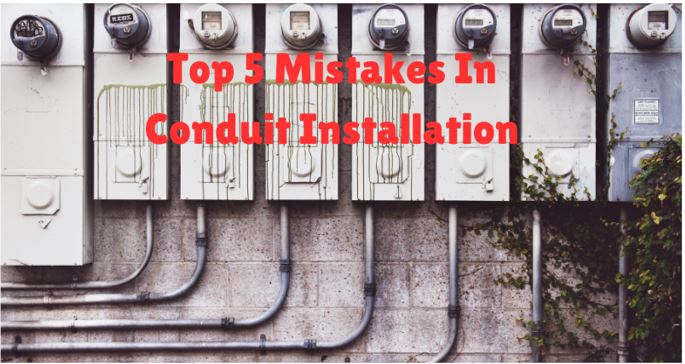Top 5 Electric Conduit Installation Mistakes and How to Avoid Them
The construction of any commercial or residential building always remains incomplete without electrical installations. In the same way, electrical appliance installation is not complete without electric conduit. It is a crucial part of the whole installation procedure.
Therefore, house owners need to understand the complete installation process of electric conduits. Not only does the house’s safety depend on the electrical installations, but they are also necessary for smooth electrical operations.
Electricians often make several mistakes during electric conduit installation. Let’s identify the top five mistakes and learn how to avoid them for a smooth operation.
Mistake 1: Incorrect Conduit Sizing
Understand Conduit Sizing
The first mistake, which is quite common, is choosing a conduit of the wrong size. A conduit is used to let wires pass through it, and if the size is not accurate, it can cause troubles in performance and also risk safety.
Consequences of Incorrect Sizing
Using an insufficient conduit might result in overheating and trouble dragging wires through, whereas an excessively big conduit can be costly and difficult to operate.
Tips for Proper Sizing
Consult the National Electrical Code: The NEC has rules for conduit sizing based on wire gauge and number.
Use Conduit Fill Calculator: These tools can help you rapidly determine the appropriate size.
Plan For Future Expansion: When deciding on conduit size, keep in mind any future wiring needs.
Mistake 2: Inadequate Support and Security
Importance of Supporting Conduits
Conduits must be properly supported and secured to prevent sagging, movement, and damage over time.
Common Errors in Supporting Conduits
Insufficient Support Spacing: Not installing supports near enough can cause drooping.
Incorrect Fasteners: Using the wrong fastener can harm the conduit.
Best Practices for Securing Conduits
Follow the NEC Spacing Requirements: Follow the NEC requirements for accurate spacing to prevent problems.
Use the appropriate fasteners: Accurate installation depends heavily on using the right-sized fasteners with appropriate space. So, always ensure that the space is accurate.
Mistake #3: Improper Bending Techniques
Why Proper Bending Matters
Bending conduits appropriately is critical to maintaining the integrity of the wiring path and allowing wires to be dragged through without harm.
Common Bending Errors
- Overbending may damage the conduit or make wire pulling difficult.
- Underbending creates abrupt angles that can damage the wires.
Correct Bending Methods
Use a Conduit Bender: This tool provides accurate and consistent bends.
Follow the Manufacturer’s Guidelines: Use the recommended bending radius for the type of conduit being used.
Mistake #4: Ignoring Expansion and Contraction
Effect of Temperature Changes on Conduits
Temperature fluctuations are quite common in electrical wires. It can cause conduits to expand and shrink, resulting in damage or disconnection if not maintained effectively.
Consequences of Ignoring Expansion and Contracture
- Conduits may crack or split owing to excessive movement.
- Connection Failure: Joints and fittings might loosen or break.
Solutions for Expansion and Contraction
- Install expansion fittings, which allow the conduit to expand and compress without damage.
- Allow for movement by leaving enough slack in the conduit runs to accommodate expansion and contraction.
Mistake 5: Insufficient Protection Against Moisture and Corrosion
Moisture and Corrosion Risk
Moisture and corrosion can dramatically reduce the life of conduits, particularly in outdoor or moist situations.
Common Mistakes When Protecting Conduits
Using Non-Weatherproof Materials: Failure to employ weatherproof conduit and fittings in outside installations.
Neglecting Protective Coatings: Not applying protective coatings or sealants to prevent corrosion.
Effective Protection Strategies
- Choose Weatherproof Conduits: Use conduits designed for outdoor or wet settings.
- Apply corrosion-resistant coatings: Regularly apply coatings to prevent rust and corrosion.
- Ensure all connections and entry points are properly sealed to avoid moisture penetration.
Conclusion
Electric conduits must be installed correctly to ensure the safety and effectiveness of your electrical system. You may ensure a strong and durable installation by avoiding typical problems such as poor sizing, insufficient support, inappropriate bending, disregarding expansion and contraction, and providing insufficient moisture and corrosion protection.
Always follow best practices and seek professional advice from experts as necessary. Proper conduit installation improves safety and extends the life and performance of your electrical infrastructure.
FAQs
What is the most common mistake in electrical conduit installation?
The most typical problem is poor conduit sizing, which can cause overheating and make wire installation difficult.
How can I verify that my conduits are properly sized?
Consult the NEC rules and use conduit fill calculators to determine the optimum size for your wiring requirements.
Why is good conduit support so important?
Proper support avoids sagging and damage, ensuring that the conduits remain stable and effective over time.
What are the risks associated with improper conduit bending?
Improper bending can harm the conduit and the wires inside, resulting in potential electrical failures.



